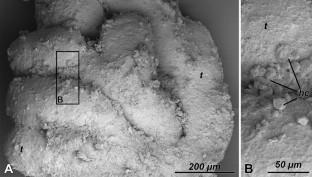Marine Biology ( IF 2.4 ) Pub Date : 2023-11-16 , DOI: 10.1007/s00227-023-04335-9 Olga V. Yurchenko , Oleg G. Borzykh , Alexander V. Kalachev

|
The ultrastructure of oogenic cells and mature oocytes has been described in a deep-sea clam, Calyptogena pacifica, for the first time. Specimens were collected in June 2018 from the Piip volcano in the Bering Sea (55.3821° N, 167.2613° E). Female germ cells developed in the branched gonadal tubules. The pattern of oogenic development is similar to that in littoral species. Although somatic accessory cells do not form any follicles around developing oocytes, these cells have a well-developed endoplasmic reticulum, which could be a source of yolk precursors and be involved in vitellogenesis. Lipid droplets appear in early oocytes, but they disappear later, suggesting that developing oocytes use these lipid droplets. At the onset of vitellogenesis, developing oocytes accumulate lipids in the ooplasm facing the gonadal tubule wall. Yolk granules, in contrast, appear at later stages of oogenesis. Mature oocytes, which are 200 µm in diameter, are filled with a significant volume of lipid droplets (occupying 24% of ooplasm) and a smaller volume of yolk granules (~ 8%). The mature oocyte’s features, i.e., the large cell size (~ 200 µm in diameter) and the high abundance of ooplasmic inclusions, are typical of species with lecithotrophic development. The large volume of lipid droplets would enhance buoyancy of the oocytes and provide embryos and larvae with nutrients during dispersal. Symbiotic bacteria were found in accessory cells, in vitellogenic oocytes, and within remnants of degenerating oocytes.
中文翻译:

深海蛤 Calyptogena pacifica(Pliocardiinae;Vesicomyidae)卵子发生的形态学方面
首次描述了深海蛤(Calyptogena pacifica)的卵细胞和成熟卵母细胞的超微结构。标本于 2018 年 6 月从白令海皮普火山(北纬 55.3821°,东经 167.2613°)采集。雌性生殖细胞在分支性腺小管中发育。卵子发育模式与沿海物种相似。尽管体细胞辅助细胞在发育中的卵母细胞周围不形成任何卵泡,但这些细胞具有发育良好的内质网,它可能是卵黄前体的来源并参与卵黄发生。脂滴出现在早期卵母细胞中,但随后消失,表明发育中的卵母细胞使用这些脂滴。在卵黄发生开始时,发育中的卵母细胞在面向性腺小管壁的卵质中积累脂质。相反,卵黄颗粒出现在卵子发生的后期。成熟卵母细胞直径为 200 µm,充满大量脂滴(占卵质的 24%)和少量卵黄颗粒(约 8%)。成熟卵母细胞的特征,即细胞尺寸大(直径约 200 µm)和卵质内含物丰度高,是卵磷脂发育物种的典型特征。大量的脂滴会增强卵母细胞的浮力,并在传播过程中为胚胎和幼虫提供营养。在辅助细胞、卵黄发生卵母细胞以及退化卵母细胞的残余物中发现了共生细菌。

































 京公网安备 11010802027423号
京公网安备 11010802027423号